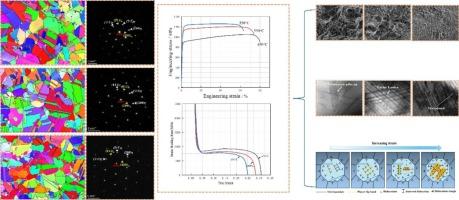Microstructure evolution and the corresponding mechanical properties of Fe-Mn-Al-C-Nb low-density steel under aging treatment
IF 7.9
2区 材料科学
Q1 MATERIALS SCIENCE, MULTIDISCIPLINARY
引用次数: 0
Abstract
To develop high-strength, low-density steels applicable for automotive field, the study systematically investigated Fe-28Mn-10Al-C-0.5Nb steel after aging at 450 °C-550 °C in terms of its microstructure evolution, mechanical properties, and deformation and strengthening mechanisms. Electron backscatter diffraction (EBSD) method served for examining the austenite grain morphology and the orientation of annealing twins at different aging temperatures. Transmission electron microscopy (TEM) served for elucidating the precipitation behavior and spatial distribution of NbC, κ-carbides, and other secondary phases. Furthermore, the deformation mechanisms under different tensile strains were explored using TEM and EBSD, with particular attention to the evolution of dislocations and other substructures in the deformed specimens. Quantitative evaluation was conducted on the yield strength variation under varying strengthening mechanisms through theoretical modeling. According to relevant results, with rising aging temperature, the finely dispersed spherical κ-carbides gradually transform into a uniformly distributed rectangular morphology. The strength and toughness of the experimental steel both increase with aging temperature, and the steel aged at 500 °C exhibits an outstanding overall property, with a tensile strength of 1199 MPa and an elongation of 37 %. Planar dislocation slip is the primary deformation mode, and the favorable strength-ductility balance results from the microband-induced plasticity. Calculations confirm dislocation strengthening as the primary strengthening mechanism in the experimental steel.

时效处理下Fe-Mn-Al-C-Nb低密度钢的组织演变及力学性能
为了开发适用于汽车领域的高强低密度钢,本研究系统研究了Fe-28Mn-10Al-C-0.5Nb钢在450℃-550℃时效后的组织演变、力学性能、变形强化机制。电子背散射衍射(EBSD)方法用于研究退火孪晶在不同时效温度下的奥氏体晶粒形貌和取向。透射电镜(TEM)分析了NbC、κ-碳化物和其他次生相的析出行为和空间分布。此外,利用透射电镜(TEM)和EBSD对不同拉伸应变下的变形机制进行了探讨,特别关注变形试样中位错和其他子结构的演变。通过理论建模,定量评价了不同强化机制下的屈服强度变化。结果表明,随着时效温度的升高,细小分散的球形κ-碳化物逐渐转变为均匀分布的矩形形态。实验钢的强度和韧性均随时效温度的升高而提高,500℃时效钢整体性能优异,抗拉强度为1199 MPa,伸长率为37%。平面位错滑移是主要的变形方式,良好的强度-延性平衡是由微带诱导塑性造成的。计算证实了位错强化是实验钢的主要强化机制。
本文章由计算机程序翻译,如有差异,请以英文原文为准。
求助全文
约1分钟内获得全文
求助全文
来源期刊

Materials & Design
Engineering-Mechanical Engineering
CiteScore
14.30
自引率
7.10%
发文量
1028
审稿时长
85 days
期刊介绍:
Materials and Design is a multi-disciplinary journal that publishes original research reports, review articles, and express communications. The journal focuses on studying the structure and properties of inorganic and organic materials, advancements in synthesis, processing, characterization, and testing, the design of materials and engineering systems, and their applications in technology. It aims to bring together various aspects of materials science, engineering, physics, and chemistry.
The journal explores themes ranging from materials to design and aims to reveal the connections between natural and artificial materials, as well as experiment and modeling. Manuscripts submitted to Materials and Design should contain elements of discovery and surprise, as they often contribute new insights into the architecture and function of matter.
 求助内容:
求助内容: 应助结果提醒方式:
应助结果提醒方式:


